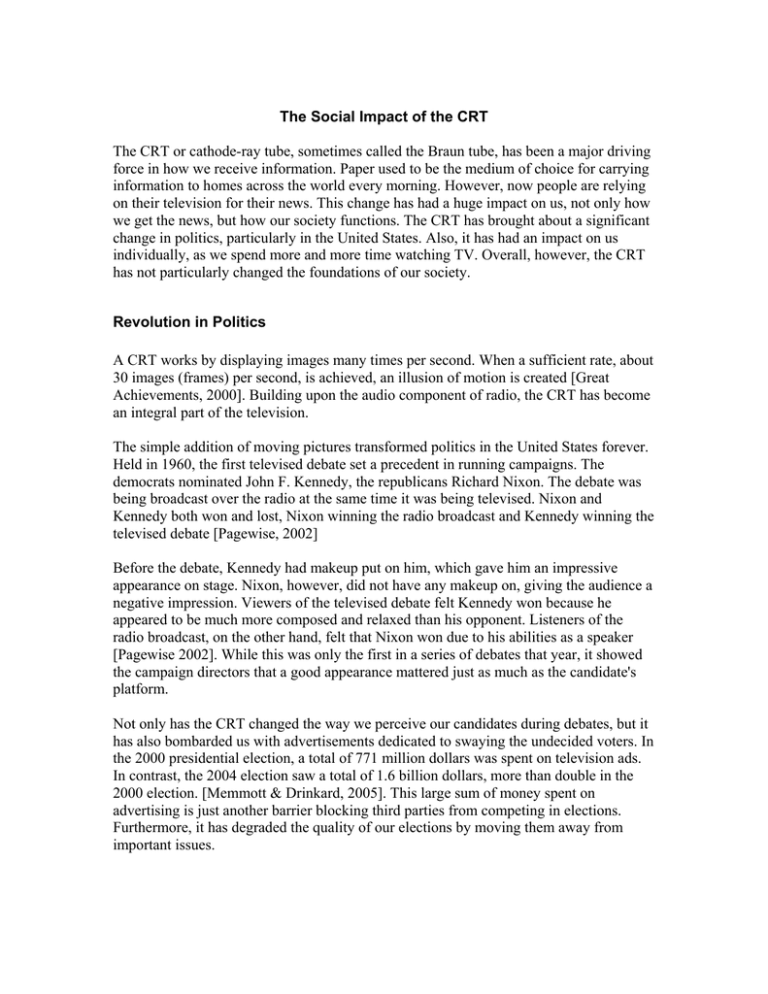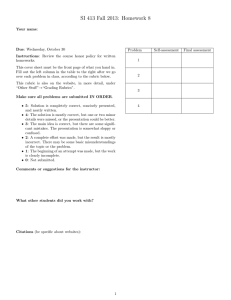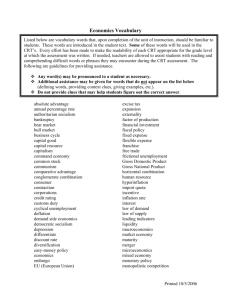The Social Impact of the CRT The CRT or cathode
advertisement

The Social Impact of the CRT The CRT or cathode-ray tube, sometimes called the Braun tube, has been a major driving force in how we receive information. Paper used to be the medium of choice for carrying information to homes across the world every morning. However, now people are relying on their television for their news. This change has had a huge impact on us, not only how we get the news, but how our society functions. The CRT has brought about a significant change in politics, particularly in the United States. Also, it has had an impact on us individually, as we spend more and more time watching TV. Overall, however, the CRT has not particularly changed the foundations of our society. Revolution in Politics A CRT works by displaying images many times per second. When a sufficient rate, about 30 images (frames) per second, is achieved, an illusion of motion is created [Great Achievements, 2000]. Building upon the audio component of radio, the CRT has become an integral part of the television. The simple addition of moving pictures transformed politics in the United States forever. Held in 1960, the first televised debate set a precedent in running campaigns. The democrats nominated John F. Kennedy, the republicans Richard Nixon. The debate was being broadcast over the radio at the same time it was being televised. Nixon and Kennedy both won and lost, Nixon winning the radio broadcast and Kennedy winning the televised debate [Pagewise, 2002] Before the debate, Kennedy had makeup put on him, which gave him an impressive appearance on stage. Nixon, however, did not have any makeup on, giving the audience a negative impression. Viewers of the televised debate felt Kennedy won because he appeared to be much more composed and relaxed than his opponent. Listeners of the radio broadcast, on the other hand, felt that Nixon won due to his abilities as a speaker [Pagewise 2002]. While this was only the first in a series of debates that year, it showed the campaign directors that a good appearance mattered just as much as the candidate's platform. Not only has the CRT changed the way we perceive our candidates during debates, but it has also bombarded us with advertisements dedicated to swaying the undecided voters. In the 2000 presidential election, a total of 771 million dollars was spent on television ads. In contrast, the 2004 election saw a total of 1.6 billion dollars, more than double in the 2000 election. [Memmott & Drinkard, 2005]. This large sum of money spent on advertising is just another barrier blocking third parties from competing in elections. Furthermore, it has degraded the quality of our elections by moving them away from important issues. Too Much Time Spent Watching the Tube As we spend more time in front of the television and computer monitor, we become more isolated from each other. In 2000, adults spent on average about two hours per day watching TV [UK National Statistics, 2000]. The CRT brings the world into our homes, we no longer have to go out and experience the world ourselves. One shocking and important example is 'reality' television. If somebody wanted to experience reality, they would usually go out and do things with friends or other people in general. Many people try to replace much of their necessary social interaction with television because it is more convenient. In other words, we have become so connected that we have become isolated. With everything being available in the comfort of your own home, people are starting to lose the desire to go out. In fact, the CRT has become such a large part of our lives that Americans spend about half of their leisure time watching TV [Bureau of Labor Statistics, 2004]. As we spend more time in front of the CRT, we spend less time socializing and taking care of our health. School aged children spend about four to five hours per day watching TV; the lack of activity while watching television is a major factor in obesity in children [Frobose, 2003]. As we start to spend more time sitting in front of a screen and less time doing physical activities, we start to neglect our health more and more. This lack of activity is greatly impacting our health, especially considering our high calorie life style. Extent of the Impact While the CRT brought a significant change in presidential elections, it did not create anything new. Before the 1960 televised debate, there was already a focus on personal appearance and public image. The CRT, however, brought that to a new level, with the information being available to everybody cheaply. Likewise, there was always money spent on ads, just not on the same scale. The CRT is slowly starting to isolate us, but it is not happening overnight. Overall, the trend seems pretty slow, and we might not really notice much of an impact during our generation. But every year, we are becoming more and more separated as we bring more of the world into our own homes. Television and computers might no longer rely on the CRT to display images, but the effects of the CRT will not go away. While the cathode ray tube has not fundamentally changed society, it has had a huge impact. Citations Bureau of Labor Statistics (2004). America Time-Use Survey. Frobose, J. K. (2003, November 11). Overweight children …too much food - too little exercise. Retrieved February 13, 2005, from http://www.ext.colostate.edu/pubs/columncc/cc031111.html Great Achievements of the 20th Century (2000). Radio and Television. Retrieved February 7, 2005, from http://www.greatachievements.org/ greatachievements/ ga_6_2.html Memmott, M., Drinkard, J. (2005).Election ad battle smashes record in 2004. Retrieved February 12, 2005, from http://www.usatoday.com/news/ washington/2004-1125-election-ads_x.htm Pagewise (2002). The First Televised Presidential Debate. Retrieved February 6, 2005, from http://ak.essortment.com/firsttelevised_rfbn.htm UK National Statistics (2000). Average time spent viewing television, video and DVD, by region and sex, 2000: Regional Trends 37.




